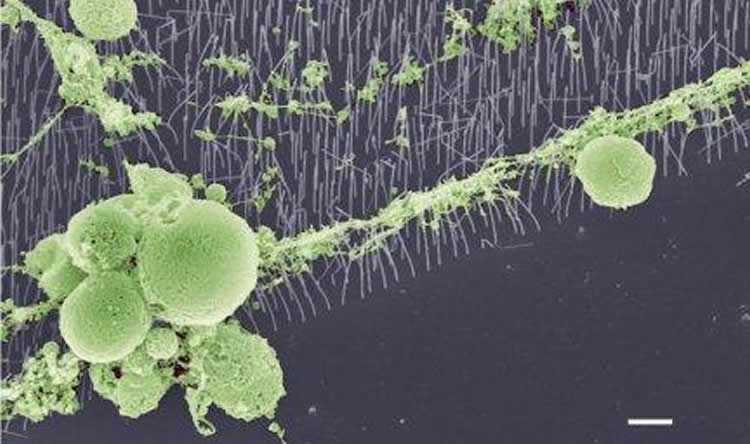Neurons thrive and grow in a new type of nanowire material developed by researchers in Nanophysics and Ophthalmology at Lund University in Sweden. In time, the results might improve both neural and retinal implants, and reduce the risk of them losing their effectiveness over time, which is currently a problem.
By implanting electrodes in the brain tissue one can stimulate or capture signals from different areas of the brain. These types of brain implants, or neuro-prostheses as they are sometimes called, are used to treat Parkinson’s disease and other neurological diseases.
They are currently being tested in other areas, such as depression, severe cases of autism, obsessive-compulsive disorders and paralysis. Another research track is to determine whether retinal implants are able to replace light-sensitive cells that die in cases of Retinitis Pigmentosa and other eye diseases.
However, there are severe drawbacks associated with today’s implants. One problem is that the body interprets the implants as foreign objects, resulting in an encapsulation of the electrode, which in turn leads to loss of signal.
“Our nanowire structure prevents the cells that usually encapsulate the electrodes – glial cells – from doing so”, says Christelle Prinz, researcher in Nanophysics at Lund University in Sweden, who developed this technique together with Maria Thereza Perez, a researcher in Ophthalmology.
“I was very pleasantly surprised by these results. In previous in-vitro experiments, the glial cells usually attach strongly to the electrodes”, she says.
To avoid this, the researchers have developed a small substrate where regions of super thin nanowires are combined with flat regions. While neurons grow and extend processes on the nanowires, the glial cells primarily occupy the flat regions in between.

“The different types of cells continue to interact. This is necessary for the neurons to survive because the glial cells provide them with important molecules.”
So far, tests have only been done with cultured cells (in vitro) but hopefully they will soon be able to continue with experiments in vivo.
The substrate is made from the semiconductor material gallium phosphide where each outgrowing nanowire has a diameter of only 80 nanometres (billionths of a metre).
Source: Lund University
Image Source: The image is adapted from the Lund University press release
Original Research: Abstract “Support of Neuronal Growth Over Glial Growth and Guidance of Optic Nerve Axons by Vertical Nanowire Arrays” by Gaëlle Piret, Maria-Thereza Perez, and Christelle N. Prinz in ACS Applied Materials and Interfaces. Published online August 11 2015 doi:10.1021/acsami.5b03798
Abstract
Support of Neuronal Growth Over Glial Growth and Guidance of Optic Nerve Axons by Vertical Nanowire Arrays
Neural cultures are very useful in neuroscience, providing simpler and better controlled systems than the in vivo situation. Neural tissue contains two main cell types, neurons and glia, and interactions between these are essential for appropriate neuronal development. In neural cultures, glial cells tend to overgrow neurons, limiting the access to neuronal interrogation. There is therefore a pressing need for improved systems that enable a good separation when coculturing neurons and glial cells simultaneously, allowing one to address the neurons unequivocally. Here, we used substrates consisting of dense arrays of vertical nanowires intercalated by flat regions to separate retinal neurons and glial cells in distinct, but neighboring, compartments. We also generated a nanowire patterning capable of guiding optic nerve axons. The results will facilitate the design of surfaces aimed at studying and controlling neuronal networks.
“Support of Neuronal Growth Over Glial Growth and Guidance of Optic Nerve Axons by Vertical Nanowire Arrays” by Gaëlle Piret, Maria-Thereza Perez, and Christelle N. Prinz in ACS Applied Materials and Interfaces. Published online August 11 2015 doi:10.1021/acsami.5b03798






